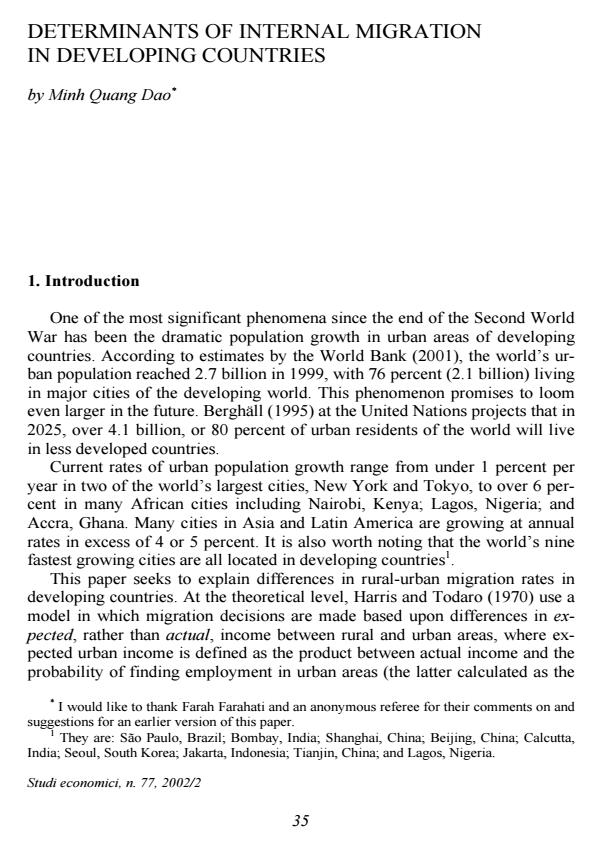Determinants of Internal Migration in Developing Countries
Journal title STUDI ECONOMICI
Author/s Minh Quang Dao
Publishing Year 1 Issue 2002/77 Language Italian
Pages 17 P. File size 173 KB
DOI
DOI is like a bar code for intellectual property: to have more infomation
click here
Below, you can see the article first page
If you want to buy this article in PDF format, you can do it, following the instructions to buy download credits

FrancoAngeli is member of Publishers International Linking Association, Inc (PILA), a not-for-profit association which run the CrossRef service enabling links to and from online scholarly content.
This paper seeks to explain differences in rural-urban migration rates among developing countries. According to the Harris-Todaro model (1970), migration decisions are made based on differences in expected, rather than actual, income between urban and rural areas. Since data on urban (or manufacturing) wages and urban (manufacturing) employment and labor force are not available for many developing countries and may be unreliable even when they exist, we choose to use the ratio of agricultural value added per worker to GDP per worker as a normalized proxy variable for rural wages and argue that the level of wages in the urban industrial sector is constant as it is determined by institutional factors such as politically motivated minimum wage legislation, efficiency wage practice by multinational corporations, and labor union pressure. Thus, variations in the ratio of agricultural value added per worker to GDP per worker may influence migration decisions of rural residents in developing countries. One important implication of the Todaro model is that indiscriminate educational expansion will result in increased migration and unemployment in urban areas. To capture this effect, we use an educational index variable, as it is readily available from the UNDP’s Human Development Report. We also hypothesize that the extent of a country’s road network, its population, area, density, and whether it is a former colony all influence internal migration rates within it. Empirical tests using three samples of developing countries show that results are more robust when interaction variables are included to account for collinearity among independent variables. In particular, we find that agricultural value added per worker is strongly significant in explaining variations in internal migration rates in two samples while the coefficient estimate on the educational variable does not have the expected sign. Road network is significant only in the case of lower-middle income countries and its impact positive when interaction variables are excluded. Population size and density may exert pressure on rural residents to migrate to urban areas in search of better economic opportunities, while the impact of colonization is only felt in the case of low-income developing countries.
Minh Quang Dao, Determinants of Internal Migration in Developing Countries in "STUDI ECONOMICI " 77/2002, pp , DOI: